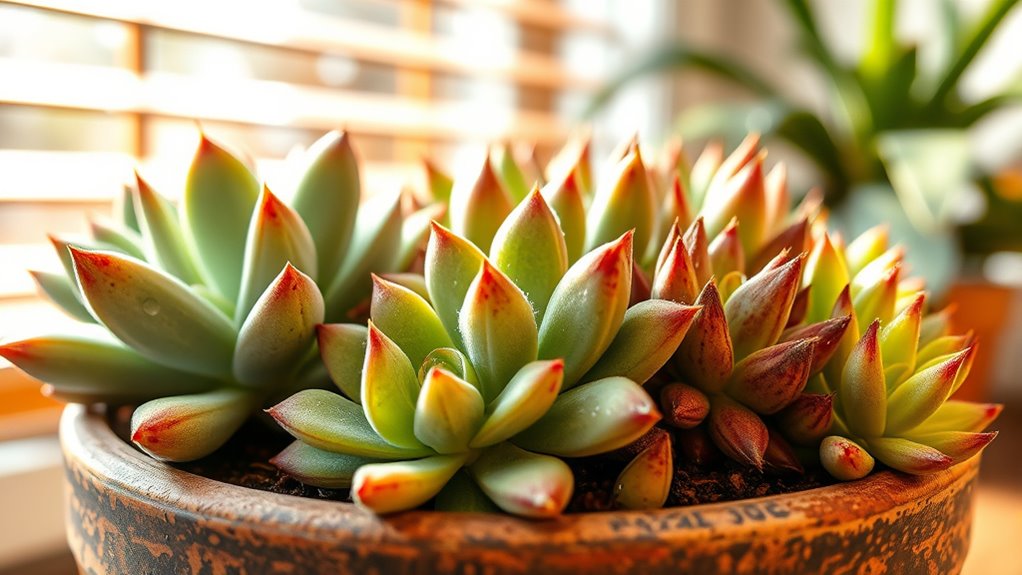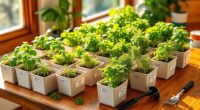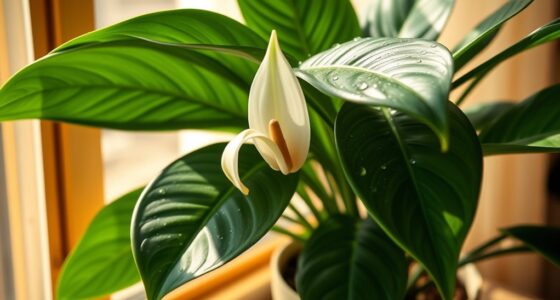To care for succulents, focus on watering only when soil is completely dry, using well-draining soil to prevent root rot, and providing 4-6 hours of direct sunlight daily. Guarantee your pots have drainage holes, and avoid overwatering by discarding excess water. Place them near south-facing windows or outdoors, and adjust light exposure based on species. Mastering these basics will help your succulents stay vibrant and healthy, and you’ll find more tips as you continue to explore succulent care.
Key Takeaways
- Water only when the soil is completely dry, and ensure proper drainage to prevent root rot.
- Provide 4-6 hours of direct sunlight daily, ideally near south-facing windows or outdoor full sun spots.
- Use well-draining soil like cactus mix with added perlite or pumice to promote healthy roots and prevent water retention.
- Maintain temperatures between 60°F and 85°F, avoiding exposure to frost or excessive heat above 90°F.
- Regularly monitor for signs of overwatering or underwatering, adjusting watering habits accordingly.
Understanding the Watering Requirements for Succulents
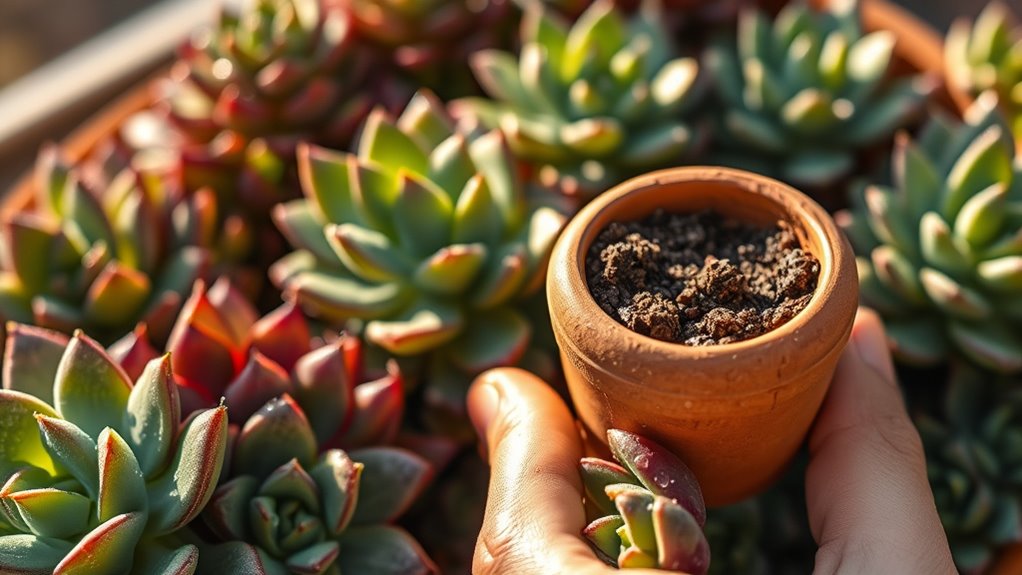
To keep succulents healthy, it’s important to understand their watering needs. Proper watering depends on well-draining soil that prevents water from sitting around the roots.
Understanding succulents’ watering needs and ensuring well-draining soil keeps them healthy.
When watering, lift the pot and pour water directly onto the soil, avoiding wetting the leaves. Make sure excess water drains out through the drainage holes, and discard any water collected in saucers after a few minutes to prevent waterlogging.
Remember, succulents store water in their thick leaves, so they only need watering when the soil is completely dry. Check the soil moisture by feeling it with your finger; if it feels dry, it’s time to water again.
Avoid overwatering, as it can cause root rot and leaf blisters, jeopardizing your plant’s health.
Identifying the Right Amount of Sunlight for Healthy Growth
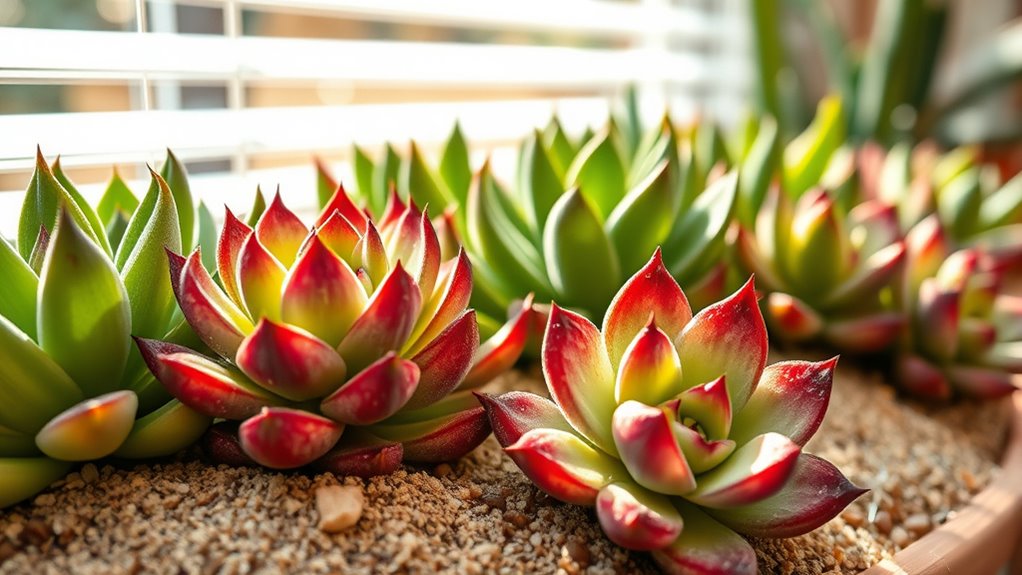
Ensuring your succulents receive the right amount of sunlight is essential for their vibrant color and overall health. Most succulents thrive with about 4 to 6 hours of direct sunlight daily. Proper placement, such as near south-facing windows or outdoor spots with full sun, helps maximize their light exposure. During winter or in shaded environments, use supplemental grow lights to provide the necessary light intensity. Remember to rotate your plants regularly to ensure even sunlight distribution, which promotes uniform growth and color. Additionally, selecting the right planter design can influence how well your succulents access sunlight and grow healthily. Being aware of the effects of inadequate light on succulents can help you adjust their environment to prevent etiolation and loss of vibrancy. Proper light management techniques are also crucial in maintaining healthy succulent growth. For example, understanding the importance of light quality can help you choose the best lighting conditions to prevent stretch and maintain compact growth.
Selecting Well-Draining Soil for Your Succulent Plants
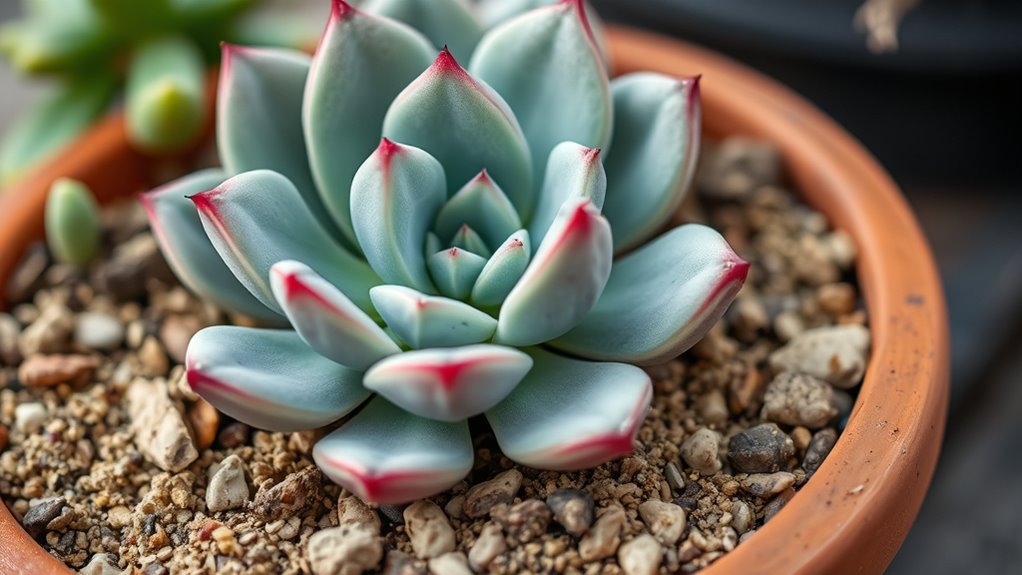
Choosing the right soil is key to keeping your succulents healthy and avoiding root rot. Look for mixes with coarse materials like sand, perlite, or pumice that improve drainage. Using well-draining soil is essential for preventing excess moisture retention. Incorporating proper soil composition can also help support the plant’s overall health and growth. If your soil stays soggy or shows signs of poor drainage, it’s time to adjust your mix to give your plants the best environment. Additionally, selecting self watering plant pots with proper drainage features can further ensure excess water doesn’t accumulate around the roots. Utilizing air circulation around your plants can also help prevent excess moisture buildup and promote healthier roots.
Soil Composition for Drainage
Selecting well-draining soil is essential for keeping your succulents healthy, as it prevents water from pooling around the roots and causing rot. To achieve proper drainage, choose a mix that includes coarse materials like cactus mix, perlite, pumice, or coarse sand. These components create air pockets and allow excess water to flow freely through the soil. Trustworthy brands offer specialized soils formulated specifically for succulents, ensuring optimal water flow and aeration. Commercially available succulent or cactus soils are formulated specifically for ideal water flow and aeration, making them a convenient choice. Before planting, ensure the soil is evenly moistened to maintain consistent moisture without waterlogging, promoting healthy root growth.
Best Soil Mixes to Use
To keep your succulents thriving, using the right soil mix can make all the difference. Choose a well-draining soil designed for cacti or succulents, or create your own by blending regular potting soil with perlite, pumice, or coarse sand. Proper color accuracy in your soil mix ensures healthier root development and better overall plant growth. Aim for at least 50% inorganic materials in your soil mix to guarantee proper drainage, preventing excess water from lingering around the roots. Avoid heavy, water-retentive soils like standard garden or indoor potting mixes, which can cause root rot. Incorporating specialized automation techniques in soil preparation can further enhance drainage and aeration. Before planting, pre-moisten the soil evenly to eliminate air pockets and promote consistent drainage. Regularly soil testing can help monitor moisture levels and nutrient balance, ensuring optimal conditions for your succulents. Using amended soil mixes tailored for succulents can significantly improve growth and resilience. When roots grow out of drainage holes or the plant needs more space, re-pot into a larger container with fresh, well-draining soil mix to maintain ideal health.
Signs of Poor Soil Drainage
When soil drainage is poor, your succulent may show clear signs of distress. You might notice roots growing out of drainage holes, indicating the soil retains too much moisture. Overwatering can cause the plant to look wilted or develop yellow, mushy leaves.
Additionally, standing water or soggy soil around the plant suggests inadequate drainage. Using inappropriate soil mixes can also increase the risk of root rot and other issues. Signs of poor drainage include:
- Roots emerging from drainage holes
- Wilting despite regular watering
- Excess moisture lingering in the soil
These issues often stem from using standard potting soil that retains moisture, rather than a well-draining mix. To prevent root rot and other problems, ensure your soil is loose and includes ingredients like perlite or pumice to improve drainage and aeration. Proper soil composition and drainage management are crucial for healthy succulent growth.
Recognizing Signs of Overwatering and Underwatering

Recognizing whether your succulent is overwatered or underwatered is essential for its health.
Overwatering signs include soft, translucent leaves that bruise or blister easily, and roots that may rot, causing the plant to wilt or collapse. You might notice swollen tissues and a generally unhealthy appearance.
Underwatering, on the other hand, manifests as shriveled, dry, and crispy leaves that lose their firmness, often dropping lower leaves prematurely. The plant may look dry overall, with edges that appear burned or crispy.
Both issues can stunt growth and discolor leaves, but overwatering usually causes soft, swollen tissues, while underwatering results in shriveled, desiccated foliage.
Additionally, understanding divorce statistics and regional legal resources can help individuals navigate the emotional and legal complexities of separation, emphasizing the importance of proper support and guidance during challenging times.
Spotting these signs early helps you adjust watering habits and keep your succulent thriving.
Adjusting Light Exposure Based on Succulent Species
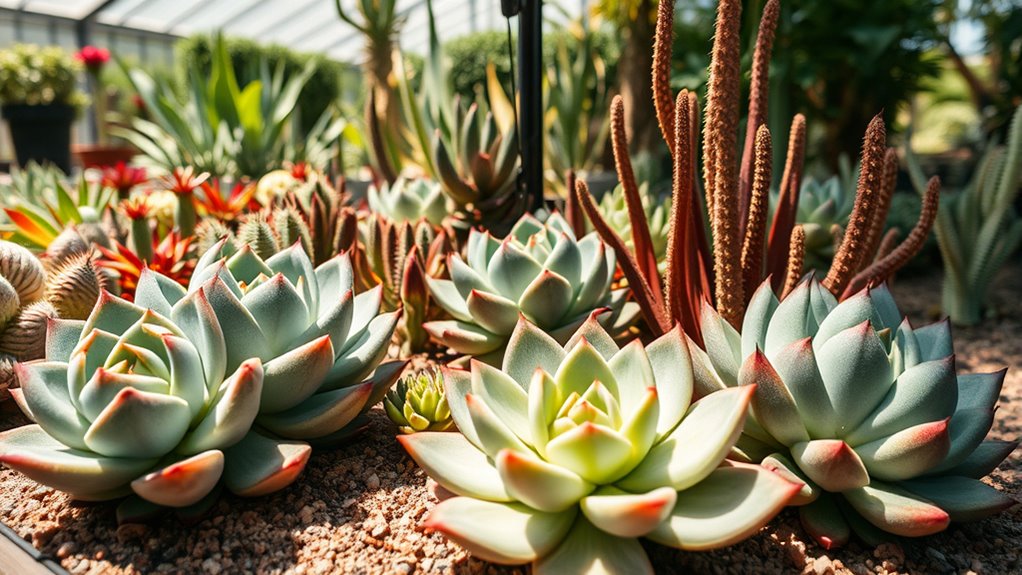
Different succulent species have distinct light requirements to thrive, so adjusting their exposure accordingly is essential. Some, like Aloe Vera and Jade Plant, need at least 6 hours of bright light or direct sunlight per day to keep their colors vibrant and shapes compact.
Others, such as Aloe Jucunda and Aloe Pepe, prefer bright indirect light and can suffer leaf scorching if exposed to too much direct sun.
Trailing succulents like String of Dolphins and String of Bananas thrive with 4-6 hours of direct sun, developing their full, elongated growth.
Be sure to gradually acclimate full-sun-tolerant succulents to prevent sunburn.
Indoor plants should be near south-facing windows or supplemented with grow lights to mimic their native full-sun environment for maximum health.
Choosing the Best Soil Mix and Repotting Tips
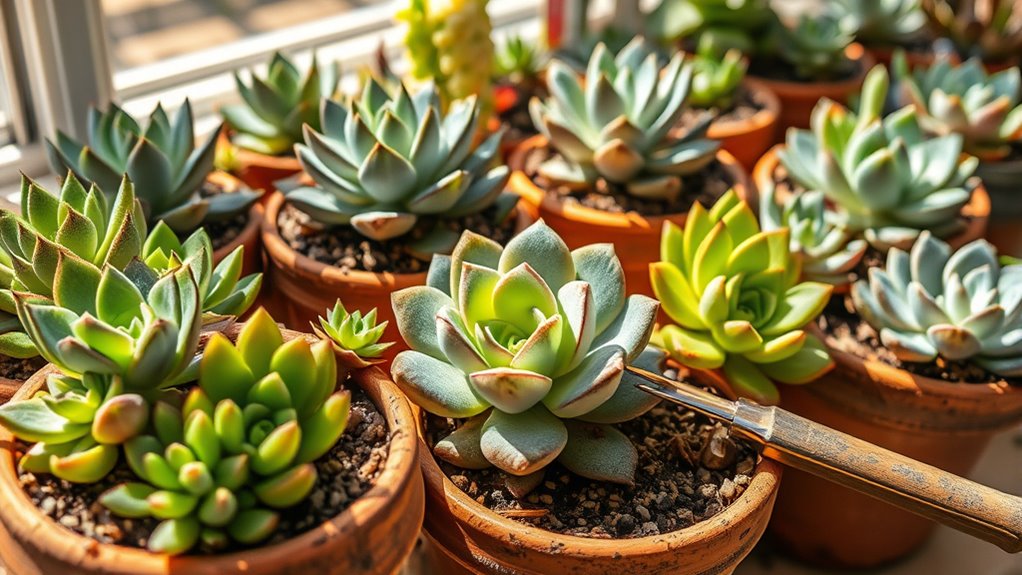
Choosing the right soil mix is essential for your succulents’ health, as their roots need excellent drainage to prevent rot. Use a coarse, gritty soil designed for cacti or succulents, incorporating perlite, pumice, or coarse sand to improve drainage.
Avoid regular potting soil, which retains too much moisture, increasing rot risk. When repotting, gently loosen the root ball and select a slightly larger container. Fill it with fresh, well-draining soil at the same soil level as before.
Adding gravel or additional coarse amendments helps mimic natural desert conditions, ensuring your succulents’ roots stay dry and healthy. Proper soil selection and careful repotting promote strong growth and prevent common issues related to poor drainage.
Creating an Optimal Environment for Succulent Care

To keep your succulents healthy, you need to find the right balance of light and temperature. Ensuring they get enough sunlight while avoiding extreme heat helps them thrive. Additionally, optimizing soil drainage prevents water from sitting around roots, which can cause rot and other issues. Incorporating soil drainage techniques can help you stay motivated and proactive in caring for your succulents, even when challenges arise. Proper storage methods, such as avoiding expired or spoiled soil or fertilizers, further support healthy growth.
Light and Temperature Balance
Creating an ideal environment for your succulents involves carefully balancing light and temperature. Too much or too little light can cause etiolation or scorching, while improper temperature affects growth and health. Aim for about 4-6 hours of direct sunlight daily, ideally near south-facing windows or outdoors in full sun. Keep temperatures between 60°F and 85°F for perfect growth; avoid temperatures below 50°F to prevent damage. Excessive heat above 90°F can lead to sunburn or dehydration, so shade or move your plants indoors if needed. To maintain balance:
- Ensure adequate light exposure without scorching
- Keep temperature within the ideal range
- Adjust water frequency based on light and temperature conditions
- Recognize the importance of proper soil drainage to prevent root rot and maintain healthy growth
Maintaining proper environmental conditions is essential for your succulents to thrive. This balance helps your succulents stay vibrant, healthy, and resilient.
Soil Drainage Optimization
Achieving ideal soil drainage is essential for healthy succulents, as it prevents water from lingering around the roots and causing rot. Use well-draining soil like cactus mix or African violet soil, amended with perlite or pumice to improve aeration and reduce water retention.
Make sure your pots have drainage holes to allow excess water to escape, minimizing the risk of root rot. Mix coarse materials such as gravel, sand, or pumice into the soil to mimic succulents’ natural dry environments and enhance drainage.
Avoid regular potting soil, which retains too much moisture. When repotting, gently loosen the soil around the roots and select containers that promote proper airflow and drainage.
These steps create an optimal environment for your succulents to thrive.
Frequently Asked Questions
How Much Light and Water Do Succulents Need?
You need to give your succulents about 4-6 hours of direct sunlight daily to keep their colors vibrant and growth healthy.
Water them only when the soil is completely dry, roughly every 2-3 weeks. Make sure to soak the soil thoroughly and let excess water drain away.
This prevents root rot and keeps your succulents looking their best. Adjust based on your environment to guarantee ideal health.
What Are the Rules for Watering Succulents?
Watering wise, you want to wait until the soil is completely dry before watering again. Typically, this means every 2-4 weeks, but it varies with environment.
You should pour water directly onto the soil, avoiding the leaves, and guarantee your pot drains well.
During dormancy or low light, cut back on watering.
Do Succulents Like Full Sun or Shade?
You might wonder if succulents prefer full sun or shade. Generally, they thrive in full sun, needing at least 4-6 hours of direct sunlight daily to stay vibrant and compact.
However, some species like Aloe Jucunda and Jade Plant can tolerate bright indirect light indoors.
Be cautious about intense midday sun, which can cause sunburn. Gradually introduce your succulents to sunlight to keep them healthy and happy.
How Much Soil Do Succulents Need?
Think of soil as your succulent’s foundation—it needs just the right amount for stability and growth. You should fill the pot with enough soil to support the roots, typically 2-3 inches deep, leaving 1-2 inches from the edge.
Use well-draining, gritty soil to prevent rot. Fill the pot only to just below the rim. This balance guarantees your succulent grows healthy and strong without feeling overwhelmed by excess soil.
Conclusion
By paying close attention to your succulent’s needs, you’ll nurture a thriving, vibrant plant that’s a true reflection of your care. With gentle adjustments to watering, light, and soil, you’ll create a cozy environment where your succulent can flourish quietly. Remember, patience and observation are your best tools—allow your plant to guide you. Soon enough, your little green companion will reward your efforts with steady growth and quiet resilience.
